Eye-Popping Book and Reading Statistics [2023]
Posted by Rob Errera on 10/04/2023
![Eye-Popping Book and Reading Statistics [2023]](https://cdn11.bigcommerce.com/s-dnybxc6/images/stencil/750x500/uploaded_images/book-and-reading-statistics-min.jpg?t=1626904362)
At a Glance: Book and Reading Stats
- Since the onset of the pandemic in 2020, a renewed interest in reading has been observed, with US print book sales rising by 8.9%.
- The global surge in reading and book sales is evident with the 2023 book market valued at $132.4 billion, and it's projected to reach $163.89 billion by 2030.
- Annually, 700,000 to 1,000,000 new book titles are released. Half of these are self-published and sell only a few copies.
- In 2021, young adult fiction saw a remarkable 30.7% growth, selling 30,974 units compared to the previous year.
- Age plays a role in reading habits in the UK: senior citizens spend average 5 hours a week, whereas individuals under 25 read for about 2.4 hours weekly.
While many people and businesses suffered in 2020, book publishers only experienced a minor dip, and actually showed gains in many areas.
Being quarantined indoors had people looking to the old stand-by — books — for a way to beat fear and boredom.
Readers stepped up in 2021, with avid readers significantly increasing their literary intake.
The latest book and reading statistics show how the industry is rebounding after a turbulent year.
Book Sales Statistics
While many people and businesses suffered during the global pandemic, book publishers thrived.
Since the start of the pandemic in 2020, print book sales in the US have risen by 8.9%, as reported by Publisher's Weekly.
In 2021, avid readers notably increased their reading.
However, in the first six months of 2023, print book sales in the US declined by 2.7% compared to the same period in 2022, decreasing from 363.4 million to 353.5 million.
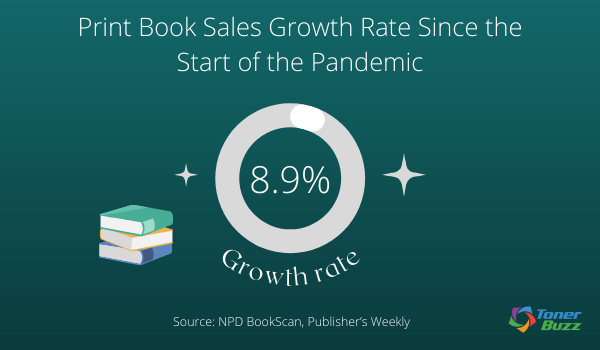
US Print Book Sales Growth Rate Since the Start of the Pandemic
Book Sales Numbers
People are cracking spines and flipping pages as book sales increase!
Books publishing statistics show increases across the board.
- Women account for nearly 80 percent of fiction sales in the US, UK, and Canada.
- After its best year in 2021, young adult fiction sales grew 3% up to the week ending November 5, 2022, representing a 50% increase compared to 2019.
- Similarly, adult fiction sales in the US also saw an uptick, increasing by 25.5% in 2021.
- Alongside, children’s fiction sales experienced a growth, rising by 9.6% in the same year.
- In the US, eBook revenue saw a growth of 11.7% in 2020 compared to 2019, and by October 2021, it had reached $84 million, as reported by AAP.
- However, by February 2023, eBook revenues experienced a decline, being down 4.8% for the month compared to February 2022, amounting to $87.5 million.
- Today, in the US, eBooks make up around 21% of total book sales.
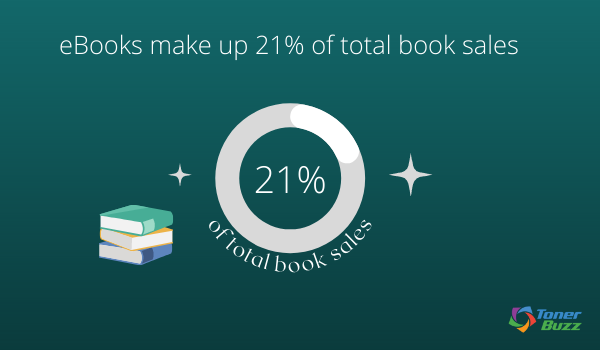
- In August 2023, Kindle Direct Publishing Select Global Fund amounted to $49.6 million, whereas in October 2021, it stood at $38 million.
- US bookstore sales were about $9 billion in 2021, up from $6.5 billion in 2020.
- However, sales in the first four months of 2022 were down 23% compared to the same period in 2019.
- In the first half of 2023, sales increased by 6.9% over the previous year, reaching $3.86 billion from $3.61 billion.
Book Sales Data
A look at the publishing industry reveals a disparity between authors and consumers.
- 700,000 to 1,000,000 new book titles appear every year. However, half of these are self-published and only sell a handful of copies.
- 50% of all published books are related to education and science.
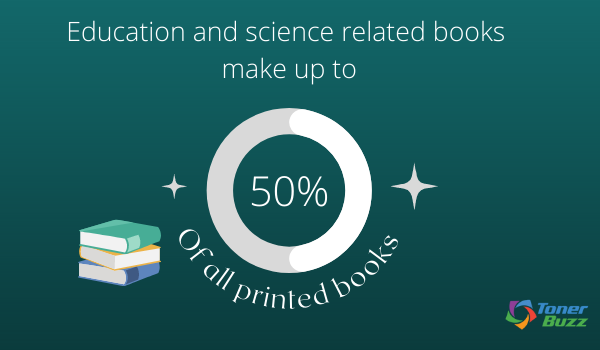
Book Sales Statistics By Year
Although there is obviously a positive trend in the book market after the pandemic, the overall trend is a little complicated.
A look at US book sales statistics by year and book sales figures by year shows how sales have dipped.
Book sales over time statistics show that reading is losing ground to other forms of entertainment year after year — unit sales are increasing but overall revenue is dropping.
Book Sales Numbers and Volume in the United States By Year
| Year | Units Sold | Book Sales |
| 2012 | 591 million | $30.9 billion |
| 2013 | 620 million | $30.6 billion |
| 2014 | 635 million | $30.5 billion |
| 2015 | 653 million | $31.3 billion |
| 2016 | 674 million | $31.3 billion |
| 2017 | 686.9 million | $31.2 billion |
| 2018 | 698.4 million | $29.3 billion |
| 2019 | 693.7 million | $27.8 billion |
| 2020 | 757.9 million | $25.7 billion |
| 2021 | 825.8 million | $27.9 billion |
(Source: Statista)
Global Book Sales Statistics 2023
The biggest worldwide players in the field of publishing include Pearson PLC, Hachette Livre, Bertelsmann, Grupo Planeta, and the China South Publishing and Media Group.
Asia and North America are the leaders when it comes to production, with both holding a 34% share of the publishing industry.
- The 2023 global book market was valued at $132.4 billion, compared to $138.35 billion in 2021.
- By 2030 this number is expected to be around $163.89 billion.
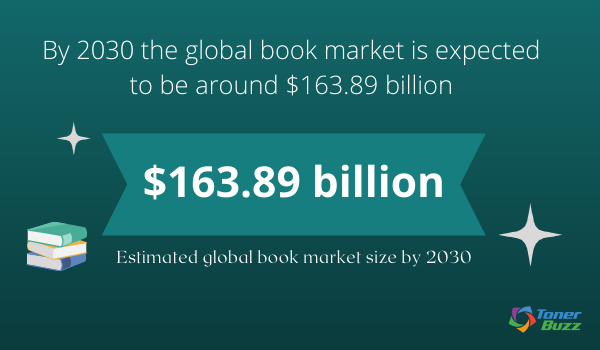
- A global average of 16.44 Euros is spent per capita on print and audiobooks.
- $12.32 billion was generated through global eBook publishing.
- The publishing industry employs 315,731 people around the world.
- eBook and audiobook sales increased by more than 30% since 2020.
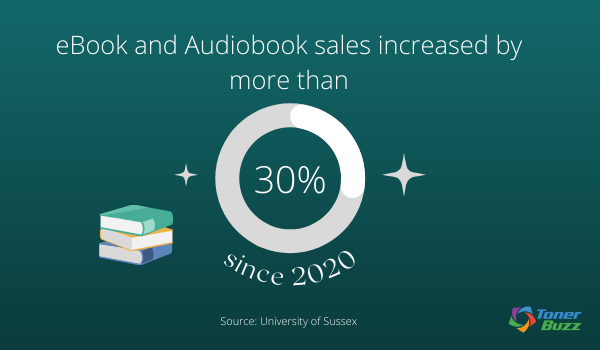
Book Sales in the United States
Book publishing has shrunk but remains a cornerstone of American business.
The pandemic drove an increase in book sales that hopefully will continue into the post-pandemic economy.
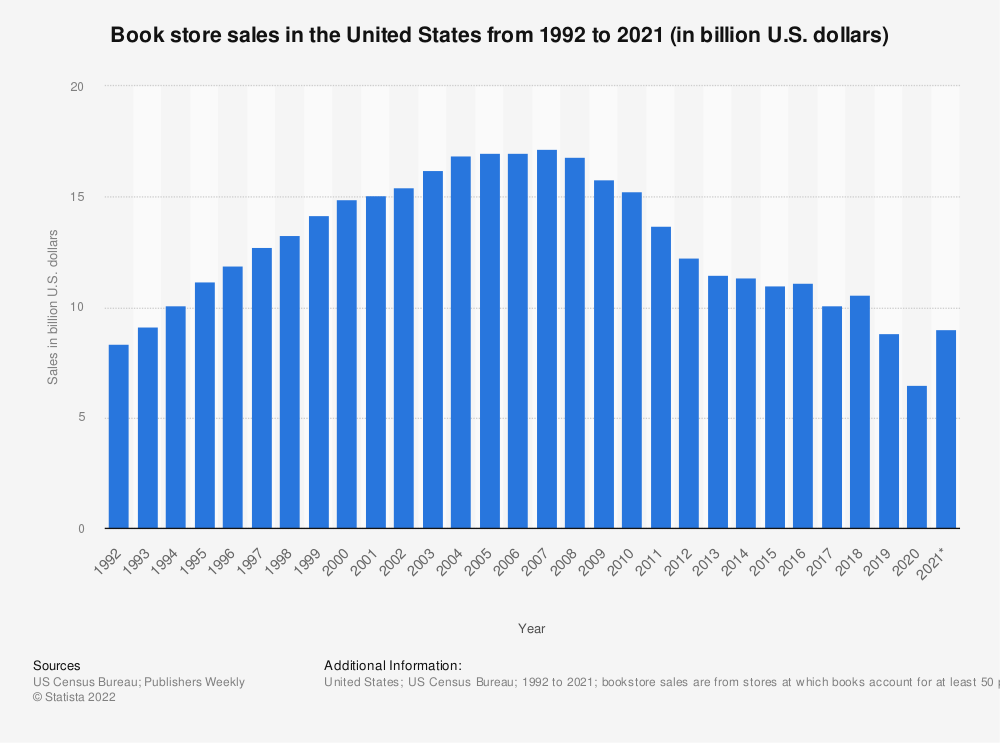
Book store sales have gone up in 2021 due to the lockdowns and the COVID epidemic.
- Households with incomes of $75,000 and above read more than households with incomes of less than $30,000.
- 788.7 million print books were sold in the US in 2022, compared to 843.1 million in 2021.
- The US book industry generated nearly $28.10 billion in 2022.
- Approximately 2,600 different companies make up the U.S. publishing industry.
- The U.S. books market is expected to generate $30 billion by 2025.
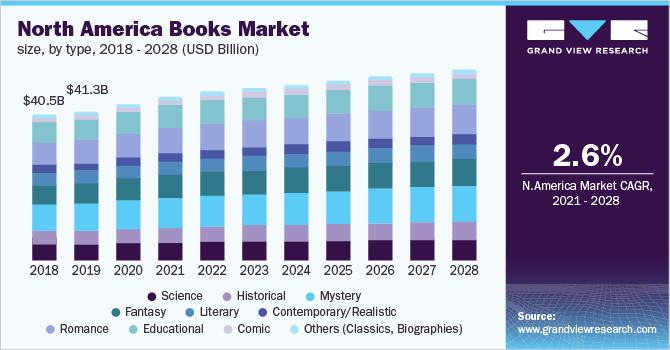
Estimated growth of the North American book market (2018-2028).
Online Book Sales Statistics
- In 2020, US books and magazines eCommerce sales value was around $18.6 billion (including audiobooks and eBooks). A $4 billion or 27.40% increase compared to 2019 ($14.6 billion).
- Online book sales in the United States totaled $16.7 billion in 2021.
- The global online book services market is expected to grow at a compound annual growth rate (CAGR) of 5.8% between 2020 and 2027. Market size is expected to expand from $18.8 billion in 2020 to $27.8 billion in 2027.
- In 2019, data from 29 national organizations of European publishers revealed that 23% of books were sold online in Europe.
Amazon Book Sales Statistics
When Jeff Bezos started Amazon out of his garage is 1994, he sold books and only books.
Amazon’s first tagline was “The World’s Largest Bookstore.”
While book sales are a fraction of its overall revenue today, Amazon is still the biggest seller of books online. Amazon remains guarded about its exact book sales statistics, but from what we could find:
- 10% of Amazon’s revenue came from book sales in 2021.
- 65% of all new book sales online in print and digital formats are made on Amazon.
- 41% of new print book sales are made on Amazon.
- 67% of all eBook sales are made on Amazon.
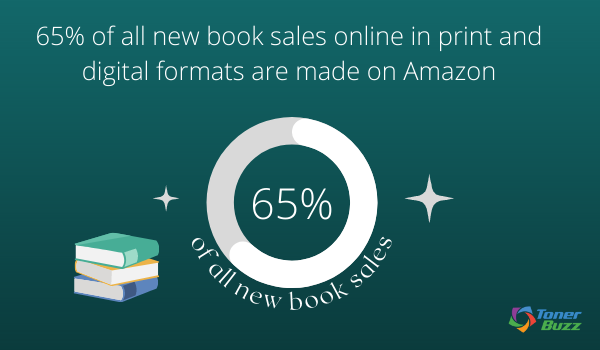
Book Sales by Genre Statistics
Readers of all ages love a good story, especially if it’s true!
Below we compare 2021 book sales with 2020 numbers.
- Adult nonfiction sold 322,564 units, a 4.4% increase over the previous year.
- Adult fiction sold 174,190 units, a 25.5% increase over the previous year.
- Juvenile nonfiction sold 75,059 units, a 6.2% decrease over the previous year.
- Juvenile fiction sold 201,868 units, a 9.6% increase over the previous year.
- Young adult fiction sold 30,974 units, a 30.7% increase over the previous year.
- Young adult nonfiction sold 4,316 units, an 8.3% increase over the previous year.
- Hardcover books sold 249,788 units, a 10.3% increase over the previous year.
- Trade paperback books sold 457,218 units, a 9.3% increase over the previous year.
- Mass market paperback books sold 38,215 units, a 3.1% decrease over the previous year.
- Children’s board books sold 49,820 units last year, a 13.2% increase over the previous year.
- Romance novels were the bestselling fiction genre ($1.44 billion).
- Religious and inspiration books were the bestselling nonfiction genre ($720 million).
Comic Book Sales Statistics
Comic books — and their more distinguish counterpart, graphic novels — saw a massive increase during the pandemic, especially in anime comic books.
- Graphic novel sales rose 65% in 2021.
- Graphic novels sales in 2020 were up 100% over 2019 sales.
- Adult graphic novels are the bestselling category of graphic novels and are up 107% from 2020 to 2021.
- Manga comic book sales increased 171.1% in 2021.
- Superhero comic book sales increased 2.3% in 2021.
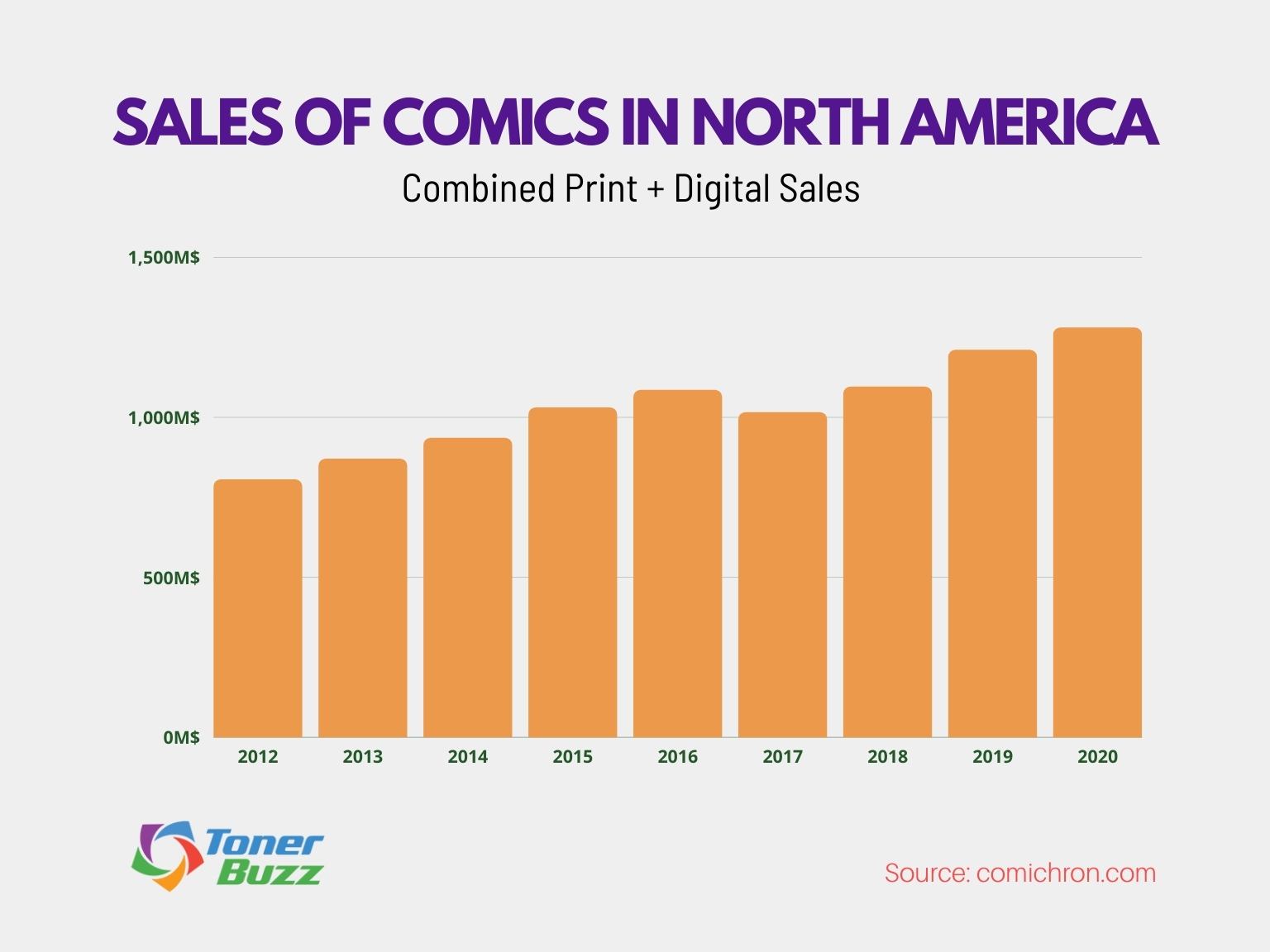
The beginning of the pandemic meant record number of comics sold, same trend continued in 2021.
Poetry Book Sales Statistics
Poetry was always a slow-selling book category until the rise of social media.
The short format and immediacy of social media platforms are ideal for online poets, and poet books have enjoyed a sales boost in recent years.
- In the UK, 1.3 million volumes of poetry were sold in 2018.
- 66% of poetry book buyers were under the age of 34.
- In the US, 28 million adults read poetry in 2017.
- Roughly 12 percent of US adults engaged with poetry, either by reading or listening to it through media, based on preliminary findings from the 2022 SPPA.
Children's Book Sales Statistics
Children’s book publishing sales show modest gains in recent years.
- $2.6 billion was generated by children’s book publishing industry in 2022.
- Children’s book sales increased 2.2% in 2022.
- Children’s book sales have increased 3.3% since 2017.
Book Publishing Statistics
Books used to be one of the most popular pastimes in the world.
Then came films and television, followed by video games, the Internet, LARPing, etc.
Competing for consumers’ dwindling attention spans is a tricky business!
But books aren’t going anywhere.
However, the way they’re being formatted and distributed has radically changed over the last few decades.
Introduced over a decade ago, eReaders offered consumers a new digital format for reading books. These digital readers allowed book lovers to:
- buy their favorite titles for less
- take them anywhere
- and change the font size and typeface
The popularity of eReaders seems to have leveled off in recent years, but Statista still projects the number of eReader users to grow from 950.5 million in 2019 to 1.11 billion by next year.

Readers can store thousands of eBooks in their eReaders and mobile devices.
Print-on-Demand Statistics
Another big change in the publishing industry is the growth of print-on-demand technology.
The technology avoids the big production runs of off-set printing and in favor of books printed one copy at a time.
This technology has allowed authors around the world to publish their own books without the need of traditional publishing houses.
As a result of print-on-demand technology, the number of book titles has increased from 2.3 million book titles published in 2013 to approximately 4 million new books being published in 2021, with nearly half of those titles coming from self-published authors.
- The print-on-demand industry has grown 12% over the past 4 years.
- A typical self-published, print-on-demand book sells less than 200 physical copies.
- The popularity of print-on-demand book publishing is expected to impact market growth.
Book publishers have jumped on the digital bandwagon, publisher statistics show, embracing e-books and audiobooks as emerging technologies for storytelling. But traditional “dead tree” editions of printed books are still the most popular format with readers.
Most Popular Book Genre Statistics
Everybody loves a good story well told, but certain types of books have a larger readership than others.
Nonfiction outsells fiction by a margin of nearly 3-to-2. In 2017, nonfiction revenues totaled $6.18 billion compared to $4.3 billion in fiction sales, according to Penguin Random House.
The Bestselling Nonfiction Title of 2022
The bestselling children’s book of last year was Dav Pilkey’s “Dog Man: Mothering Heights.
In fact, USA TODAY reported “Dog Man: Mothering Heights” was the bestselling book in all categories.
The second bestselling book last year was Kristin Hannah's epic love story, “The Four Winds.” Coming in third was “American Marxism,” Mark Levin’s political tome.
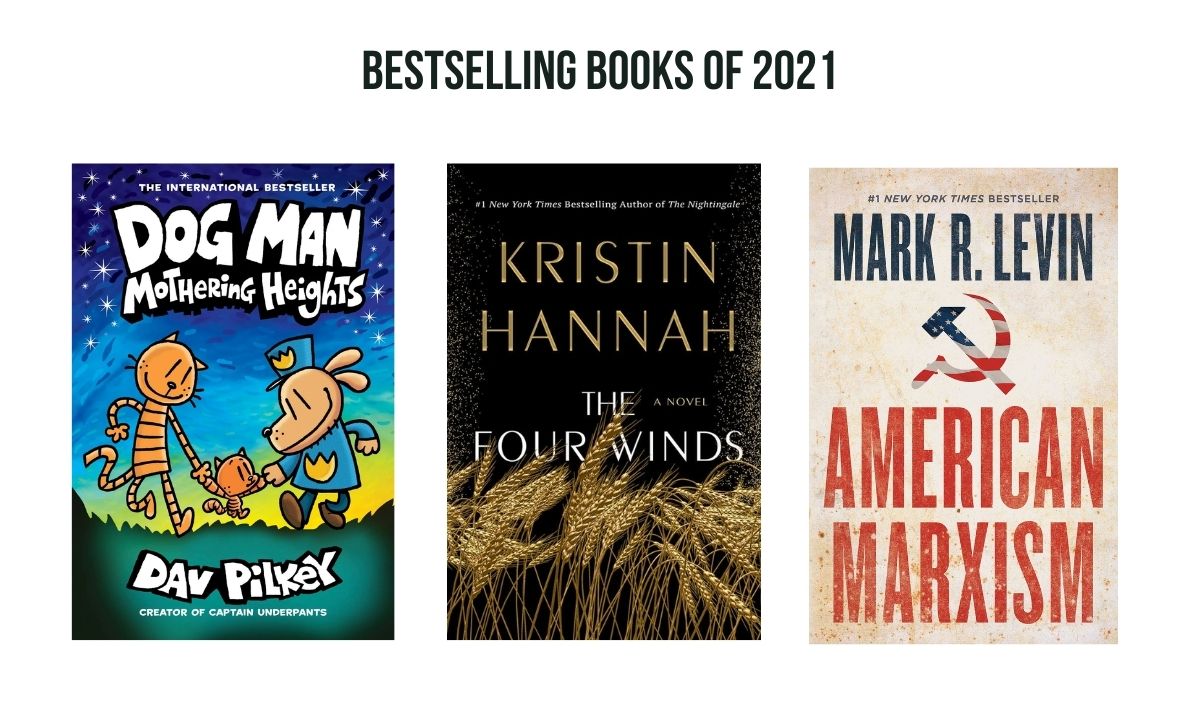
One thing is certain; diehard readers have their favorite genres and they stick to them.
Romance novels enjoy an audience of voracious readers; they buy a lot of books and they read a lot!
Last year, romance novels raked in $1.44 billion.
According to Query Tracker, young adult is the most popular fiction category, followed by:
- fantasy novels
- children’s fiction
- literary fiction
- science fiction
- and thrillers
Romance placed 9 out of 10 on the list.
QT’s most popular nonfiction genres are:
- memoir
- self-help
- narrative
- religion/spirituality
- cultural/social issues
- biographies
Proactive Writer says the bestselling print book categories on Amazon are:
- Memoirs and Biographies
- Self Help
- Religion and Spirituality
- Health, Fitness, and Dieting
- Politics and social sciences
The bestselling eBook categories on Amazon are:
- Religion/Spirituality
- Biographies and Memoirs
- Business and Money
- Self Help
- Cookbooks, food, and wine
The genre fiction categories that generate the most sales are:
- Romance ($1.44 billion)
- Crime/Mystery ($728.2 million)
- Religious/Inspirational ($720 million)
- Science fiction/fantasy ($590.2 million)
- Horror ($79.6 million)
The bestselling audiobook genres are:
- Fiction and Literature
- Mystery/Thriller/Suspense
- Science fiction/fantasy
- Romance
- Business and Money
Quick fact: thrillers are the bestselling genre of audiobooks.
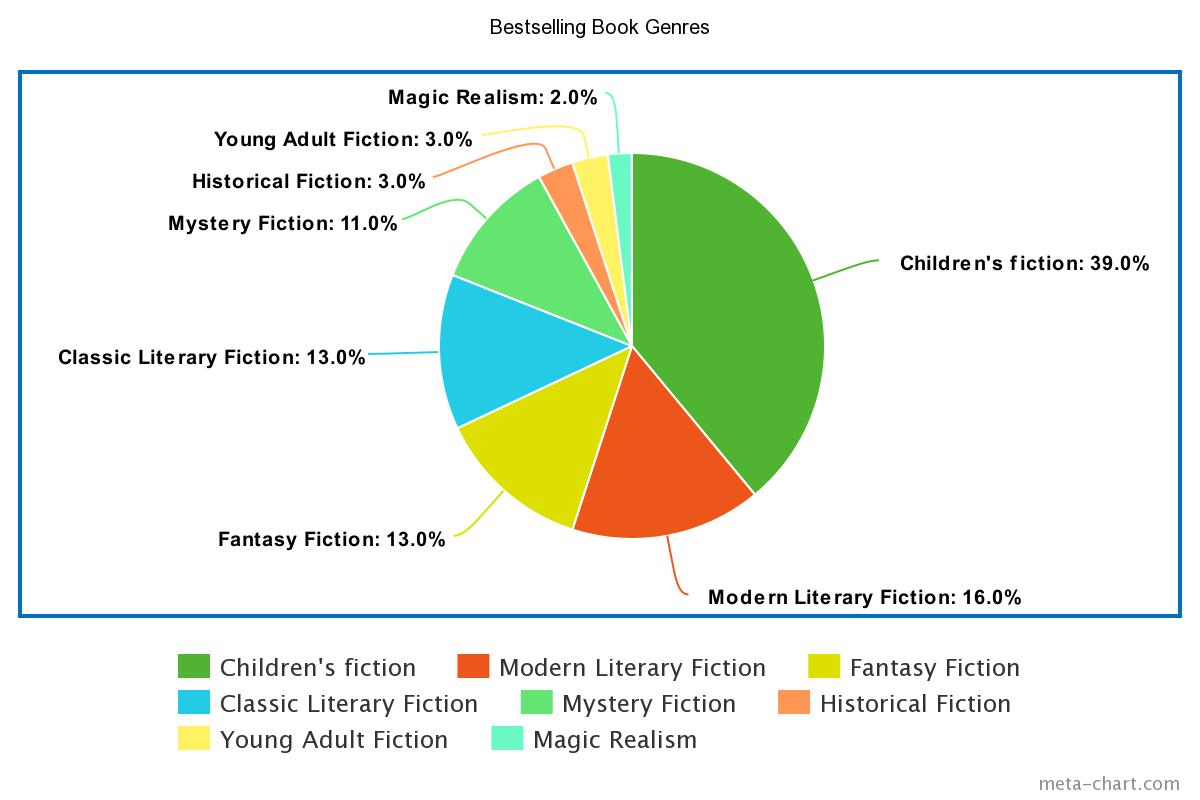
Comprehensive overview of the most popular book genres in 2021.
Audio Book Statistics
- The worldwide audiobook market is projected to grow to $35.04 billion by 2030, with an estimated CAGR of 26.3% between 2023 and 2030.
- Between 2010 and 2020 the number of audiobooks published increased from approximately 6,000 to more than 71,000 per year - this is a 1083.33% increase in ten years!
- Audiobook sales generated $1.8 billion in revenue in 2022, compared to $1.3 billion in 2020.
- 30% of readers aged 18-to-29 listened to an audiobook in 2021, compared to only 12% of readers aged 65 and older.
- An average of 23% of American readers also listen to audiobooks.
- 25% of women in the US listen to audiobooks, up from 22% in 2018
- 22% of men in the US listen to audiobooks, up from 19% in 2018
- 12% of senior citizens in the US listen to audiobooks
- 20% of US consumers listened to an audiobook last year
- 138 million audiobooks were borrowed from libraries in 2021
- Smartphones are the most popular devices for listening to audiobooks
- Literature and fiction is the leading audiobook genre in the US
- 56% of US audiobook listeners are under the age of 45, a 4% increase from last year
- 46% of US adults say they’ve listened to an audiobook, a 2% increase over last year
- Audiobook listeners listened to an average of 8.1 books in 2020, up from 6.8 in 2019.
eBook Statistics
- 22% of US readers use e-readers, like a Kindle or a Nook, to read e-books.
- 191 million eBooks were sold in 2020.
- Over $1 billion was spent on eBooks in 2020.
- eBook readers spend between $19 and $25 each year on eBooks.
Book Reading Statistics
Reading is fundamental and the latest book reading statistics in the world bear this out.
Even though reading habits have changed drastically over the years, the joy and benefits of reading remain constant.
A statistic on reading from Gallup suggests reading is losing popularity as an American pastime. But benefits of reading statistics show the power and importance of reading.
Reading exercises your “brain muscles.”
According to book reading statistics in the US compiled by Expert Editor suggest reading 30 pages — or for 30 minutes — per day can:
- Stimulate neural pathways
- Keep the brain active and elastic
- Decrease mental decline in the elderly by 32%
- Improve memory
- Promote new synapse growth
2022 Reading Statistics: A Banner Year For Readers
Information and statistics provided by researchers at Pew Research and Publisher’s Weekly confirm that people are reading more than ever.
But that doesn’t mean more people were reading.
It means people who were already readers read more.
Why do people read more?
One of the prime reasons was the rise of homeschooling.
Parents needed to read to children, from board books for pre-readers to content for first readers attempting to sound out words. With school libraries on lockdown, caregivers searched online for what they needed to promote literacy skills in their children.
But there are other factors to consider when looking at the recent years book market. People simply had more free time to read. They also had more access via e-readers and eBooks.
In addition, there was an increasing desire among American families for words of comfort and understanding. Regardless of age, race, or household income, people across the nation sought information, entertainment, or distraction last year.
Books had what they needed.
Reading Statistics Across The Globe
Are books still popular? Regardless of age or country of origin, readers around the globe sought to enrich their lives through reading stats, data, facts, and diverse topics. Stats on reading suggest people are returning to the simple pleasure of reading.
- Just over half of the UK adult population reads regularly for pleasure.
- Senior citizens in the UK spend an average of 5 hours a week reading.
- UK readers under 25 read an average of 2.4 hours per week.
- 28% of China’s total 2016 publishing sales were e-books.
- Print still accounts for the bulk of total units sold.
- E-book sales are strongest in Korea (80.1%), Brazil (54.6%), and Norway (29.1%).
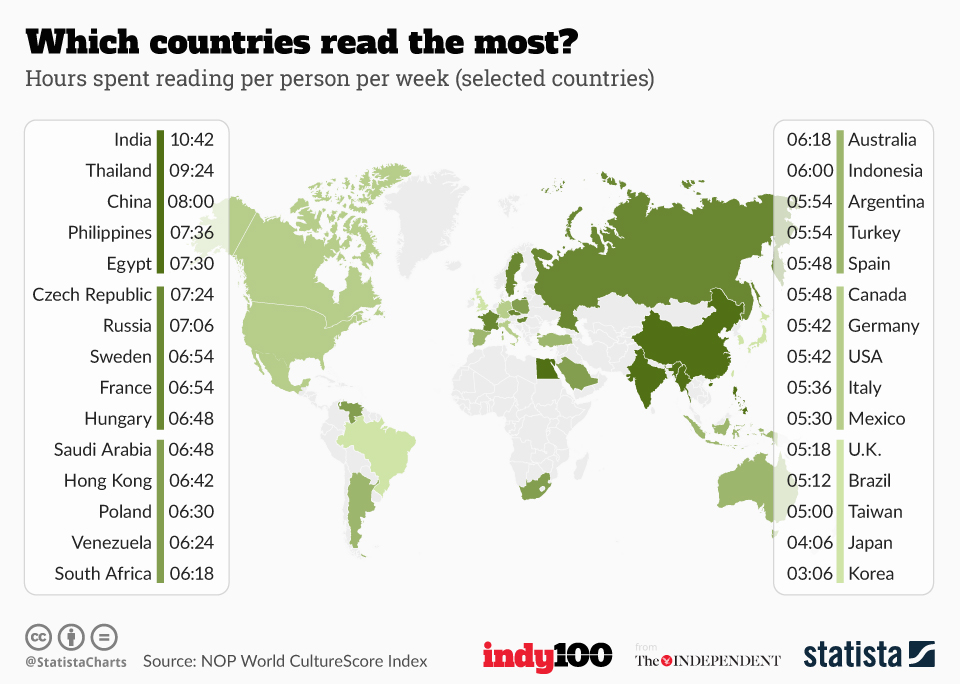
Asians are among the most passionate readers on the planet.
Reading Statistics in the United States
America is great … except for reading.
According to Pew Research, one of the prime reasons children in the United States hover near the middle of the pack in global literacy skills is that there are not enough adult readers enkindling that love of words in the next generation.
The often-cited — yet sketchy — NOP World Culture Score Index is a global survey that places the U.S. in 22nd place in reading statistics.
According to the NOP, the average U.S. adult reads approximately five hours a week, while top readers in India, Thailand, China, Philippines, and Egypt clock between 7.5 - 10.5 hours per week reading.
Do Americans today read more or less than 20 years ago?
In 2017, Americans read an average of 16.8 minutes per day (not including work and school materials). This is a 26% decrease from 2005 when Americans read an average of 22.8 minutes per day.
The average American reads 12 books a year, according to Pew Research, but that number is deceiving.
The median number of books read per year in the United States is four, meaning half the country reads less than 4 books per year.
A Closer Look At United States Reading Statistics
It’s a fact — reading makes you smart and keeps your mind sharp regardless of age.
There are a number of life benefits that stem from reading! Improve your life by reading something more challenging than a restaurant menu!
- 14% of US adults — 32 million Americans — cannot read.
- 27% of US adults didn’t read one book in 2015.
- Total US newspaper circulation fell 11% between 2016 and 2017, the 28th consecutive year of decline.
- While traditional paper editions of newspapers continue to decline in per day readership, the popularity of online newspapers is growing. The New York Times saw a 47% increase in digital subscriptions in 2017, while The Wall Street Journal saw a 23% rise in digital readership.
- 18% of total US book sales in 2016 were digital.
- Adult fiction and nonfiction generated $5.1 billion in revenue in 2018.
- The average US household spends $118 on reading annually, including newspapers and magazines.
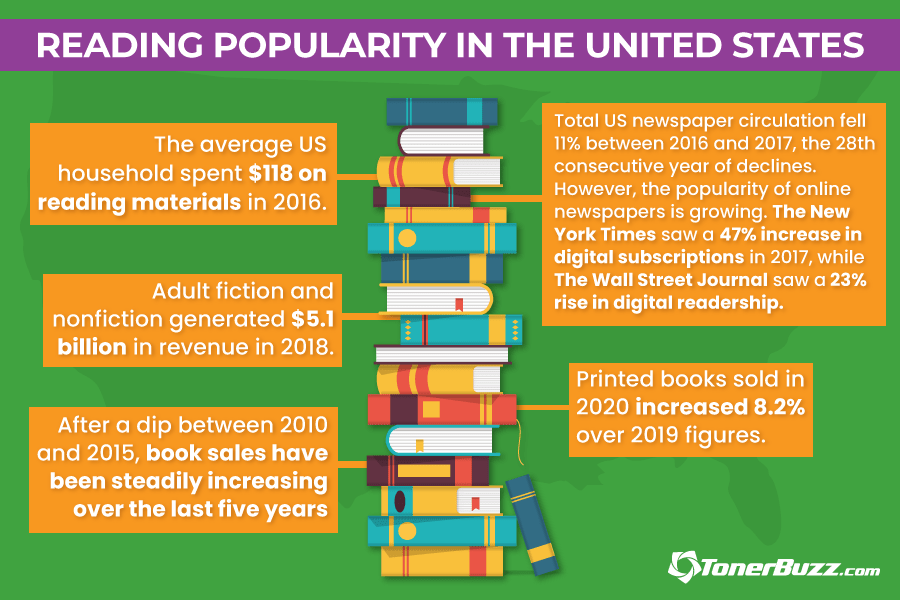
Reading statistics and reading habits in America

Reading skills and reading gains develop at all grade levels and ages.
Reading Statistics and Students
Reading acquisition is one of the more important life skills children must learn.
- Children typically start to read around age six or seven.
- Books expose children to 50% more words than primetime television.
- 65% of all U.S. fourth grade students in 2013 scored “below proficient” in reading skills.
- 35% of fourth-graders could not read at grade level.
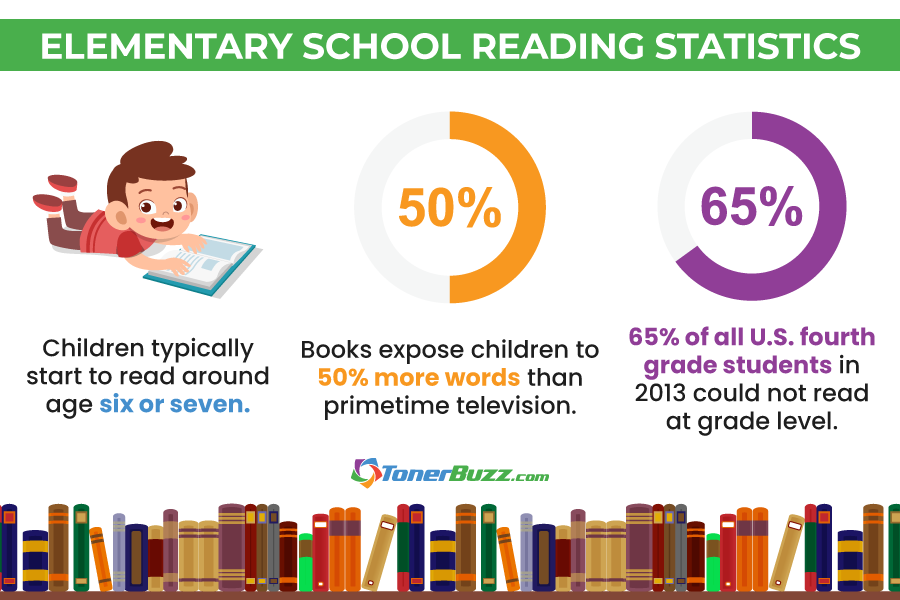
The latest reading statistics show younger children reading more.
Reading Statistics and High School Students
- More than 60% of high school seniors read below grade level.
- 27% of high school seniors cannot read at a “basic” level.
- Teenagers from book-loving homes had 42% better vocabulary grades than those that didn’t.
- Reading proficiency scores for American high school students haven’t improved since the 1970s.

First-through-fifth graders weren’t the only young students reading more in 2020. Middle graders and high schoolers read more during the pandemic as well!
Books and College Students
- A typical college student spends an average of between $1240 and $1420 per year on textbooks.
- 66% of college students say they have avoided buying class materials because of steep prices.
- 25% of college students work extra hours to afford textbooks.
- 11% of college students have skipped meals in order to buy course materials.
- 19% of college students say the cost of textbooks directly influences which classes to take.
2020 was the year U.S. middle-grade students and high schoolers dusted off the reference books and “worked from home”.
Reading Statistics and Elementary School Students
Reading acquisition is one of the more important life skills children must learn, according to the latest reading in America statistics.
- Children typically start to read around age six or seven.
- Books expose children to 50% more words than primetime television.
- 65% of all U.S. fourth grade students in 2013 scored “below proficient” in reading skills.
- 35% of fourth-graders could not read at grade level.
Child Reading Statistics
While the benefits of reading to young children are well documented, a deeper look at the benefits of reading to children statistics shows how reading continues to benefit children well into adulthood.
Children’s Literacy Gets A COVID Stimulus
As schools closed and parents taught from home, demand for juvenile nonfiction titles rose.
- Juvenile nonfiction saw a 23.1% boost in print.
- Young adult nonfiction saw a 38.3% boost in print.
- The popularity of graphic novels rose 29% in 2020.
- Education/Reference/Language increased 55.5%.
- Game/Activities/Hobbies increased 31.3%.

Reading to kids before they can read on their own helps young readers navigate the parts of a book, like the table of contents, index, and copyright page.
Statistics On Reading To Your Child
More than one child education study suggests a child with access to age-appropriate content shows achievement in all areas of course work.
A look at statistics about reading shows how the pandemic lockdown helped boost overall reading behaviors among children.
According to Publisher’s Weekly, two of the best-selling books of last year were Big Preschool Work (790,000 copies) and My First Learn-to-Write Workbook (703,000 copies), underscoring just how much homeschooling of young children was undertaken by parents or a family member last year.
Getting kids into books while they’re young — even before they can read — is an essential part of early childhood development. Mothers and fathers who read to their children inspire a lifelong love of reading. In turn, these children will pass the reading bug on to their own children when they’re grown.
Exposing kids to data and facts can prompt questions in children of any age. This is an often overlooked aspect of reading. Think about content for kids. One fact read by a third-grade child can spark a lifelong love of education!
Reading to young children is vital for improving literacy skills. Listening to parents talk can help improve comprehension skills, word association, and overall childhood literacy.
Reading and success in life statistics suggest children develop better reading skills and reading comprehension as adults when they are read to as kids. Students that develop good reading habits have an easier time hitting education-level goals as they move through grade school.
Here are some numbers about reading to your child:
- 89% of kids (6-17 age groups) said their favorite books are the ones that they picked by themselves.
- 72% of kids (6-11 age groups) think reading-aloud together with their parents is fun.
- 31% of children 6-11 (age groups) who were being read aloud agree it made them love reading.
- Parents encourage 82% of kids to read books for fun.
- Followed by teachers who encourage 67% of kids to read books for fun.
Benefits of Reading Statistics
It’s a fact — reading makes you smart and keeps your mind sharp regardless of age. There are a number of life benefits that stem from reading! Improve your life by reading something more challenging than a restaurant menu!
Crack a book and you might just avoid a trip to the doctor’s office! Reader statistics show that readers are healthier in both body and mind.
- People who read regularly are kinder, according to a Kingston University study on reading facts and statistics.
- Reading comedic fiction increases your empathy toward others.
- Children who read for pleasure have greater vocabulary growth and cognitive skills.
- Reading keeps you out of jail. Sixty percent of all inmates cannot read. Prisoners that learn to read have a 16% chance of returning to prison, compared to a 70% recidivism rate for inmates who never learn to read.
- Reading is more important for a child’s cognitive development than their socio-economic upbringing or their parent’s education.
- 19% of readers say spending time with a book makes them feel less lonely.
- People with high literacy skills report a stronger sense of belonging to society and are more likely to trust others.
- Pleasure readers have higher levels of self-esteem and a great ability to cope with difficult situations.
- Reading for as little as six minutes slows heart rates and eases tension.
- Reading is 300% better at reducing stress than walking, and 700% better than playing video games.
- Reading reduces stress by 68 percent, more so than listening to music, having a cup of tea, or taking a walk.
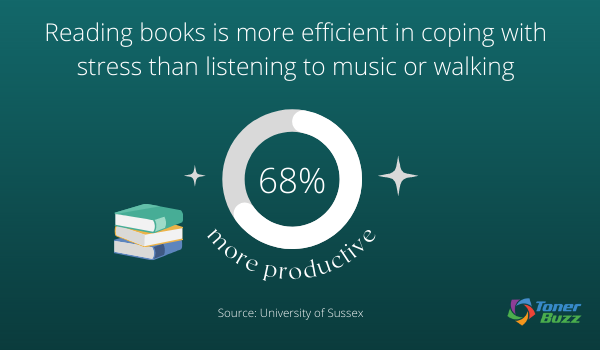
- Reading for pleasure helps prevent stress, depression, and dementia.
- Reading fiction is a way to improve language development and vocabulary as well as brain connectivity and function.
- Lifelong readers have lower rates of Alzheimer’s and other forms of dementia than their peers.
- 50% of people who read before bed report better sleep than non-readers.
- Less than 50% of U.S. citizens read novels, short stories, plays, and poetry.
Top Three Bestselling Books of All-Time
- The Bible - five billion copies (registered by Guinness World Records in 2021)
- The Works of Mao Tse-tung - 820 million copies
- The Harry Potter Series - 500 million copies
Connecting with Readers
While it may seem old-fashioned compared to modern entertainments like virtual reality gaming, reading still offers the most immersive and intimate entertainment experience.
Authors put emotions and ideas that exist solely in their minds into words. Readers consume those words and experience the same thoughts and emotions.
You’re inside the brain of another person! It doesn’t get more intimate or immersive than that!
- Print book sales figures have improved and unit sales now consistently surpass 650 million per year.
- 825.75 million print books were sold in 2021.
- Print book sales have increased approximately 9% year-over-year since 2012.
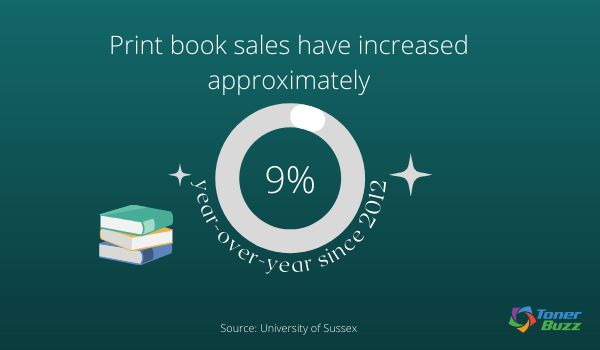
- 65% of US adults read a print book in 2021.
- Book sales generated $27.9 billion in revenue in 2021.
- There are 4,100 independent bookstores in the United States.
Readers find what they need on printed pages!
A Book Is Brain Food
Reading is fundamental and the latest book statistics bear this out. Even though reading habits have changed drastically over the years, the joy and benefits of reading remain constant.
Facts About Reading
Check out these interesting facts about reading! Reading facts is where it’s at!
- Bibliosmia is the experience of enjoying that “new book smell.”
- The printing press was invented by Johannes Gutenberg between 1440-50 in Germany.
- The Gutenberg Bible, printed in 1455 in Mainz, Germany, is often cited as one of the first books.
- Several books in the Harvard Houghton Library are bound in human flesh.
- “Codex Leicester” or the “Hammer Codex” by Leonardo Da Vinci was sold at auction to Bill Gates for $30.8 million in 1994.
- Mark Twain’s “The Adventures of Tom Sawyer” (1876) was the first novel written on a typewriter.
Reading brings generations of families together!
Further Reading:
- Facts About Paper: How Paper Affects the Environment
- Deforestation Facts and Statistics
- How Many Books Are Published Each Year? [2022 Statistics]
https://www.grandviewresearch.com/industry-analysi...
https://www.the-tls.co.uk/articles/why-women-read-...
https://www.authorsguild.org/industry-advocacy/boo...
https://www.statista.com/topics/1177/book-market/#...
https://www.statista.com/statistics/197710/annual-...
https://authornews.penguinrandomhouse.com/book-pub...
https://www.usatoday.com/story/entertainment/books...
https://proactivewriter.com/blog/how-to-pick-a-gen...
https://querytracker.net/top-10-genres.php
https://publishingperspectives.com/2021/10/aap-sta...
https://www.printful.com/blog/print-on-demand-repo... https://www.technavio.com/report/publishing-market...
https://www.statista.com/statistics/422595/print-b...
https://www.techtarget.com/searchaws/feature/Amazo...
https://www.publishersweekly.com/pw/by-topic/indus...
https://www.comicsbeat.com/report-graphic-novel-sa...
https://www.thebookseller.com/news/poetry-summit-7...
https://www.arts.gov/stories/blog/2018/taking-note...
https://poets.org/
https://www.ibisworld.com/industry-statistics/mark...
https://www.nytimes.com/2020/06/16/books/bookshop-...
https://www.healthychildren.org/English/ages-stage...
https://nces.ed.gov/nationsreportcard/subject/publ...
https://thencbla.org/literacy-resources/statistics...
https://webarchive.nationalarchives.gov.uk/ukgwa/2...
https://nces.ed.gov/pubsearch/pubsinfo.asp?pubid=1...
https://educationdata.org/average-cost-of-college-...
https://www.countryliving.com/uk/wellbeing/news/a1... https://www.scholastic.com/content/dam/KFRR/PastRe... https://www.researchgate.net/publication/234585142... https://www.statista.com/statistics/1273249/book-s... https://www.literacymidsouth.org/news/the-relation... https://readingagency.org.uk/about/impact/002-read...
https://natlib.govt.nz/schools/reading-engagement/...
https://www.telegraph.co.uk/news/health/news/50708...
https://www.fastcompany.com/3048913/how-changing-y...
https://www.psychologytoday.com/us/blog/the-athlet...
https://n.neurology.org/content/81/4/314
https://www.sleepjunkie.com/books-and-bedtime/
https://interestingliterature.com/2017/07/on-the-s...
https://www.britannica.com/topic/publishing
https://www.theverge.com/2014/6/4/5780644/harvard-...
https://artradarjournal.com/2022/03/02/what-did-bi...
https://www.openculture.com/2013/03/mark_twain_wro...
https://www.businesswire.com/news/home/20210413005...
https://www.grandviewresearch.com/press-release/gl...
https://www.ibisworld.com/global/market-research-r...
https://publishdrive.com/2021-book-market-report-b...
https://www.pewresearch.org/fact-tank/2021/09/21/w...
https://www.wipo.int/edocs/pubdocs/en/wipo_ipa_pil...
https://www.pewresearch.org/fact-tank/2017/02/15/u...
https://www.bls.gov/news.release/atus.nr0.htm
https://www.smithsonianmag.com/smart-news/27-perce...
https://www.pewresearch.org/fact-tank/2017/06/01/c...
https://www.fool.com/slideshow/heres-what-average-...
https://www.arts.gov/sites/default/files/ReadingAt...
https://www.guinnessworldrecords.com/world-records...
https://www.forbes.com/pictures/lml45effkg/j-k-row...
https://www.statista.com/statistics/249854/audiobo...
https://www.statista.com/statistics/426799/e-book-...
https://experteditor.com.au/blog/brain-books-benef...
https://www.comichron.com/yearlycomicssales/indust...
https://www.statista.com/chart/6125/which-countri...





